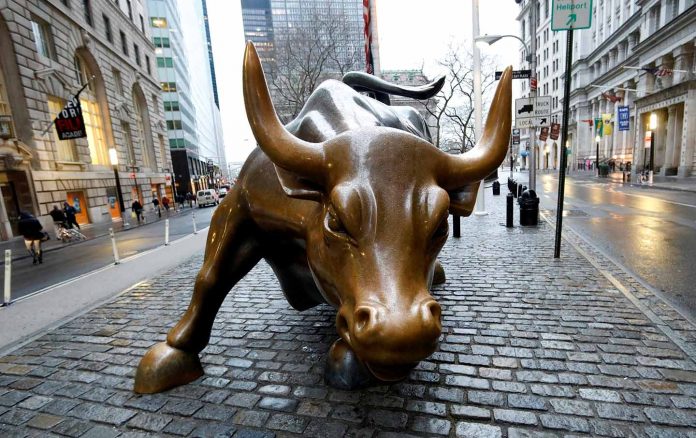LONDON: World shares were set for their best week of gains in six years on Friday after two consecutive weeks in the red, shrugging off a rise in global borrowing costs while the dollar hit its lowest since 2014.
MSCI’s world index of stocks, which tracks shares in 47 countries, was up 0.3 percent after European bourses opened. .MIWD00000PUS After suffering its biggest weekly drop since August 2015 last week, the index is now on track for its best showing since early December 2011.
Some investors have been puzzled at the quick rebound, which has coincided with a rise in bond yields on signs that inflation is starting to creep up globally.
The argument commonly offered by economists has been that historically, it is not unusual for stocks and bond market borrowing costs to rise in tandem in a rapidly expanding economy.
“For me it’s really a question of maybe. Markets are taking a look at the inflationary outlook and saying OK, maybe rates are going up and maybe the economy will compensate for that,” said Michael Hewson, chief markets analyst at CMC Markets.
“That might change if we move to 3 percent on the 10-year (U.S. Treasury yield).”
The global rise in borrowing costs has been led by that instrument, which hit a four-year high of 2.944 percent this week. It stood at 2.8877 percent on Friday. US10YT=RR
Yields across the euro area were mostly steady, although Germany’s benchmark Bund was within sight of 2-1/2-year highs and set for its biggest weekly rise in eight weeks. DE10YT=RR
Investors were also watching for a sovereign debt rating update on Greece from Fitch, set for release later in the day.
European shares were also set to chalk up healthy weekly gains, snapping a three-week losing streak as earnings updates continued to impress, and volatility and jitters over rising inflation eased.
Among country benchmarks, the UK’s FTSE .FTSE was up 0.6 percent and Germany’s DAX .GDAXI added 0.5 percent, while Italy’s FTSE MIB .FTMIB was up 1 percent.
The pan-European benchmark is up 3 percent so far this week, set for its best week since December 2016, but still down around 6 percent from the 2-1/2-year peak it hit in January.
With many Asian markets closed on Friday for the Lunar new year, MSCI’s broadest index of Asia-Pacific shares outside Japan .MIAPJ0000PUS rose 0.3 percent.
Japan’s Nikkei rose 1.2 percent, with investors relieved to see the government appoint Bank of Japan Governor Haruhiko Kuroda for another term, suggesting the central bank will be in no rush to dial back its massive stimulus program.
Equity investors have drawn a degree of reassurance from a fall in the VIX .VIX index – a measure of implied volatility on the S&P 500 index, also known as Wall Street’s “fear gauge”.
The index dropped below 20 for the first time since it spiked to a 2-1/2-year high of 50.3 last week, a jump that caused massive losses among investors who bet equity markets would stay stable on a combination of solid economic growth and moderate inflation.
“While the ‘Goldilocks’ risk environment from January appears to be fading, we do not believe we are on the cusp of a protracted risk sell-off, because the global growth cycle remains strong in our view,” Credit Agricole strategists said in a note to clients.
DOLLAR IN THE DUMPS
Extending the previous day’s losses, the dollar’s index against a group of six major currencies fell to 88.676 .DXY, the lowest since December 2014. The index was on track to lose around 2 percent on the week in its largest decline since February 2016. Against the yen, the greenback fell to its lowest in over a year.
There is no strong consensus yet on what is driving the dollar’s persistent weakness, especially in light of rising yields. Some say it simply reflects a return of risk appetite and a shift to higher-yielding currencies, including many emerging market ones.
But others cite concerns that Washington might pursue a weak dollar strategy as well as talk that foreign central banks may be reallocating their reserves out of the dollar.
There are also worries President Donald Trump’s tax cuts and fiscal spending could stoke inflation and erode the currency’s value.
“You could say that right now, rather than stocks rising around the world, it is the dollar falling against almost everything,” said Yoshinori Shigemi, global market strategist at JPMorgan Asset Management
Oil prices maintained this week’s gains, with U.S crude futures trading at CLc1 $61.55 per barrel, up 4.1 percent so far this week. Brent crude traded at $64.77.
Virtual currency bitcoin recovered the $10,000 mark for the first time in two weeks BTC=BTSP before easing to $9,844.82, down over 1 percent on the day.




